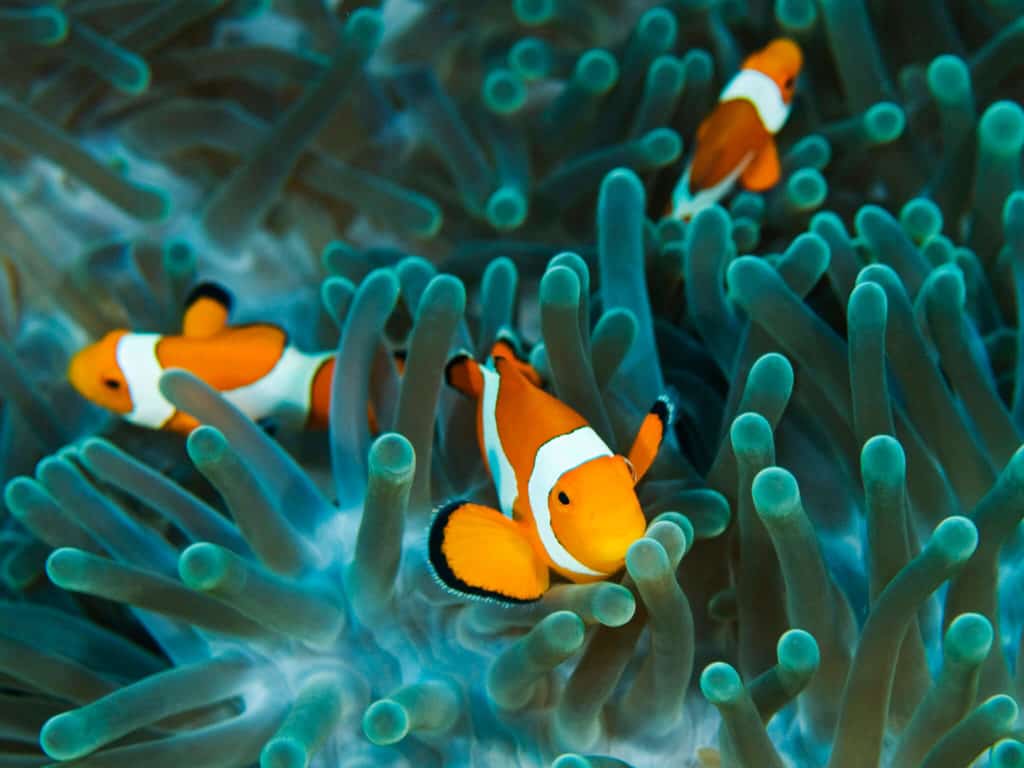With 30 total species of clownfish inhabiting our warm and tropical oceans, these fish are some of the most fascinating creatures that have a range of different characteristics and attributes.
They can often be found in tropical reefs being protected by anemones and defending their eggs fiercely against predators.
In this post, we’re going to take a closer look at one of the most fascinating clownfish abilities and answer, do clownfish change genders?
Yes, all clownfish start off as male but some are able to change genders when circumstances allow. Male clownfish can change to female clownfish in order to breed and lay eggs.
Can Clownfish Change From Male To Female?
Clownfish can change from male gender to female depending on the social environment which allows them to breed.
The biological change inside the clownfish is governed by hormonal changes and chemical shifts that trigger a complex and cascading effect.
As these fish start their lives as males, some of the fish need to change gender in order for the fish to reproduce.
However, once the fish changes sex from male to female, there is no going back as it is a one-way ticket.
Why Do Male Clownfish Turn Into Females?
Clownfish are sequential hermaphrodites and are just one of the hundreds of species of fish that undergo sexual transition.
I will assume that those reading this article are well acquainted with the clownfish and anemone symbiotic relationship before we go further, but that’s a post for another day.
Clownfish in the wild live around anemones for protection, but they also live in groups. The largest of the group will change from a male to a female.
The female clownfish will only mate with the breeding male, which is now the largest and most aggressive male clownfish in the group.
The rest of the group consists of sexually immature males. When the alpha female dies or gets lost, the breeding male will become the first in line to gain weight and transform from male to female.
From there, every fish in the group grows and move up in the hierarchy, then the largest of the non-breeders will turn into the breeding male.
Bottom line is that in the world of clownfish, size does matter, as does aggression.
After the transformation, the female will lay eggs for the male to fertilize and the mother will defend the nest whilst the father protects the eggs.
Sometimes even the non-reproductive male clownfish are allowed to live on the same anemone as the female and breeding male, and if for some reason the female disappears her male mate instantly starts taking on female behaviors in preparation for transition.
How Long Does It Take For Clownfish to Change Genders?
Although clownfish do have the ability to change genders, it’s still a timely process and one that does not happen instantly.
The main transcriptional response driving sex change at the brain level was found to be completed 30 days after the removal of the original dominant female.
While the differential expression is still detected in the gonads 50 days after the removal of the original female, although sex change is completed when males become immature females.
How Can Clownfish Change Genders?
Clownfish are able to change genders because they are what is known as sequential hermaphrodites, they are born with both male and female reproductive organs.
When the time is right for the breeder male to become the female, a fascinating biological change governed by hormonal change takes place.
The actual DNA of the fish does not change, but the expression of different genes does. The most obvious change happens in the set of genes involved in the expression of gonadotropin-releasing hormones (GnRH).
The testes dissolve and the ovaries form, but it’s not an overnight process and takes around 30-days to fully transition.
Latest studies show that the male-to-female sex change occurs first in the brain and is then followed by the transformation of gonads, sometimes after a delay of months or sometimes even years.
Are All Clownfish Born Male?
Yes, all clownfish are born male but they do have the ability to switch their sex if they do reach the top of the hierarchy and need to become female.
Although clownfish are born male, they do carry both male and female reproductive organs which allows them to switch when conditions allow.
In any given clownfish community, the female is the largest and most dominant fish, with the breeding male the second largest and the rest immature males.
These immature male clownfish are able to turn into females if the alpha female dies.
Final Thoughts
So, do clownfish change genders? Yes, they certainly do. When circumstances allow, the most dominant clownfish will undergo the transformation from a male fish to a female.
Once complete, the female will lay eggs often on the anemone and then the breeding male will fertilize the eggs and protect them until they hatch.
Clownfish are born with both male and female reproductive organs which allows them to change sex if they reach the top of the hierarchy and become most dominant.
Only the most aggressive and dominant clownfish reach the top of the hierarchy and make the transition from male to female.
Hopefully, this post has been helpful and you’ve learned something new today about clownfish changing genders.

Hi, I’m George – the founder of MarinePatch. I created this blog as marine wildlife has been my passion for many years. I’ve spent over a decade in the marine wildlife industry and spent years out in the field conducting research. In today’s modern world, an online blog is the best place for me to share my findings and reach as many people as possible to help educate and inspire others. Enjoy your time here and you’re welcome back anytime!

